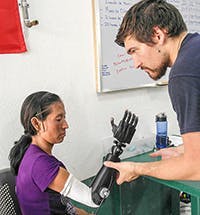It’s a hot August afternoon in Baltimore at Camden Yards, and a 5-year-old baseball fanatic from Las Vegas named Hailey Dawson nonchalantly jogs across the first base line onto the field. The girl, dressed in a bright orange Orioles shirt and matching hairbands for her shoulder length ponytails, halts a few yards in front of home plate, poised to throw out the ceremonial first pitch. Her favorite player, Orioles’ third baseman Manny Machado, is crouched, waiting with an outstretched glove.
Today her right hand, which has a stunted pinky and thumb, with the middle three digits nearly nonexistent, is sheathed in a different kind of glove: an orange and black 3D-printed prosthesis articulated by wrist movements, called the Flexy-Hand 2. It’s the reason she’s here.
“My goal initially when I approached the Orioles is to get this out there that anybody can get this hand, anybody can use this to help adapt in their daily lives,” Hailey’s mother Yong Dawson says. “All you have to do is ask.”
The Flexy-Hand allows Hailey, who was born with Poland Syndrome, to actually hold the ball, which she quickly releases. It skips once before Machado, who has two Gold Gloves, scoops it up. The crowd roars and the pitcher and catcher embrace.
The amazing technology that made Hailey’s hand whole is normally described in sterile, industrial monikers such as additive manufacturing and rapid prototyping. That space is, of course, where it’s the most profitable and continues to innovate. When you work with it every day, as many manufacturers do, it’s easy to forget that for some, a 3D printer is like Santa Klaus in a box. And the gifts it gives may provide the opportunity for someone to ride a bike, cut food, or even breathe without pain — things most of us take for granted.
Helping Hand
Yong got Hailey this particular hand by contacting the University of Nevada, Las Vegas’s engineering department in May 2014. Hailey already had a Robohand, designed in South Africa and printed locally with the help of e-NABLE, an online network that facilitates the 3D printing of prosthetics.
The e-NABLE community has already supplied 700 people with 3D-printed devices. The most notable was the myo-electric arm developed by Limbitless Solutions and its founder, college student Albert Moreno. A video posted in March involving Robert Downey Jr. and an “Iron Man”-themed robotic arm for a 7-year-old has 10 million views on YouTube.
The first 3D-printed prosthetic Hailey received was crude by comparison. Brendan O’Toole, professor of mechanical engineering, saw that it needed extensive work to remove pinch points and improve functionality. He immediately agreed to take on the project, as a way to give his students, who usually design and print C-clamps and gears for their 3D printing project, a real-world problem to solve.
It also was Hailey’s best chance to get a right hand that could grip a bike handle or grasp a small object before she reached adulthood. Normally, someone in Hailey’s position would have to wait until she stopped growing to get a prosthetic, which can cost $20,000 to $30,000.
“To make this in a traditional manufacturing method would never be economical, since almost every one of these hands has to be customized a little bit to be useful,” says O’Toole. “To print the whole new hand and components was probably under $200 in material costs.”
He didn’t get to see Hailey throw out the first pitch in Baltimore but was there when she did the same at a UNLV game this past March. He also was there in October when Hailey picked up a dry-erase marker and casually wrote her name on the whiteboard.
“I wanted her to be able to do things everybody else could do without possibly having limitations,” Yong says. “Riding her bike, she can steer with two hands now.”
While the father in O’Toole is happy Hailey can ride a bike or swing a bat now, his engineering side is not satisfied with the current Flexy-Hand.
“It gave her some functionality, but it’s not a replacement for a living hand,” he says. “There’s a lot of engineering that could be done to make it better.”
He wants to decouple the finger gripping from wrist motion and apply motorization, projects currently underway. Applicable sensors and motors exist, but the dilemma, as with most engineering projects, is to do it with low-cost components.
The professor promises to keep working on it, and Hailey’s story has resonated in the school, with more students wanting to join in.
“It’s so life-changing for the people involved,” O’Toole says. “For me it’s something I want to stay involved with and make it a huge part of my research life going forward.”
Feeling the Future
At the end of “Empire Strikes Back,” Luke Skywalker has a pretty traumatic family reunion, followed by the loss of his right hand in a lightsaber duel. He gets a replacement covered in synthetic skin that can actually sense. Our lightsaber technology is currently lacking, but Dustin Tyler, a professor at Case Western Reserve University working with the Cleveland Veterans Affairs Medical Center, may have found a way for amputees to feel through the artificial device.
Tyler has found a way to restore sensation to the phantom right forearm of Igor Spetic, who lost the appendage in a forging hammer accident while making jet parts in 2011.
A series of wires runs from Spetic’s synthetic hand, feeding data collected by the pressure sensors to an algorithm that translates it into electrical impulses. Those are sent to electrode implants in his fleshy bicep and up to the brain, which registers.
“The perception of touch occurs in the brain, not in the hand itself, so losing the limb is really just losing the switch that turns that sensation on or off,” Tyler explains.
“The value and opportunities offered by 3D printing are indeed tantalizing for our work,” Tyler said via email. “We currently do not utilize it at the level we probably should.”Spetic can now discern different textures, such as sandpaper, at 19 different points in the artificial hand. Another patient can distinguish 16.
The work is years away from being replicated outside of a lab, but by the time Hailey is an adult, this tech could be available. It also has amazing implications for wounded war veterans. Since 2001, the Congressional Research Service reports there have been 1, 645 major limb amputations.
Fortunately, Tyler can focus on the neural pathways for now, as many researchers are already optimizing 3D printing parts. Victoria University in Canada, for example, is trying to make prosthetics available to amputees on a global scale.
The 3D-printed Victoria Hand only costs around $200 each using the Ultimaker². Equipped with sensors and an adaptive grasp to pick up coins or eggs, it boasts incredible flexibility for the cost.
The creator, Prof. Nikolai Dechev, who works with the amputee-geared Range of Motion Project, has begun initial work in Nepal and Guatemala, the latter of which suffered a bloody civil war from 1960 to 1996.
“In Canada, nine out of 10 amputees are born that way,” Dechev told the Times Colonist. “Down there, it’s something like eight out of 10 are through trauma.”
His website, VictoriaHandProject.com, estimates that 3 million people are in need of upper-limb prostheses, but only 5% have access. In America, there are about 41,000 upper-limb amputees, and only half ever receive prosthetic services, according to Brown University. As 3D printing drives the cost down and sensor technology makes them more effective, this number should drop substantially.
And for those who need them, their opportunities to live the fullest life possible increase exponentially. The next time Hailey Dawson is holding a baseball on the field, it will be as a player. Her mother Yong plans to sign her up for a baseball league next season. She will also continue raising awareness about the availability of hands like Hailey's.
“With 3D printing, it’s going to be so inexpensive,” Yong says. “There’s not going to be an excuse for anybody."
About the Author
John Hitch
Editor, Fleet Maintenance
John Hitch, based out of Cleveland, Ohio, is the editor of Fleet Maintenance, a B2B magazine that addresses the service needs for all commercial vehicle makes and models (Classes 1-8), ranging from shop management strategies to the latest tools to enhance uptime.
He previously wrote about equipment and fleet operations and management for FleetOwner, and prior to that, manufacturing and advanced technology for IndustryWeek and New Equipment Digest. He is an award-winning journalist and former sonar technician aboard a nuclear-powered submarine where he served honorably aboard the fast-attack submarine USS Oklahoma City (SSN-723).




